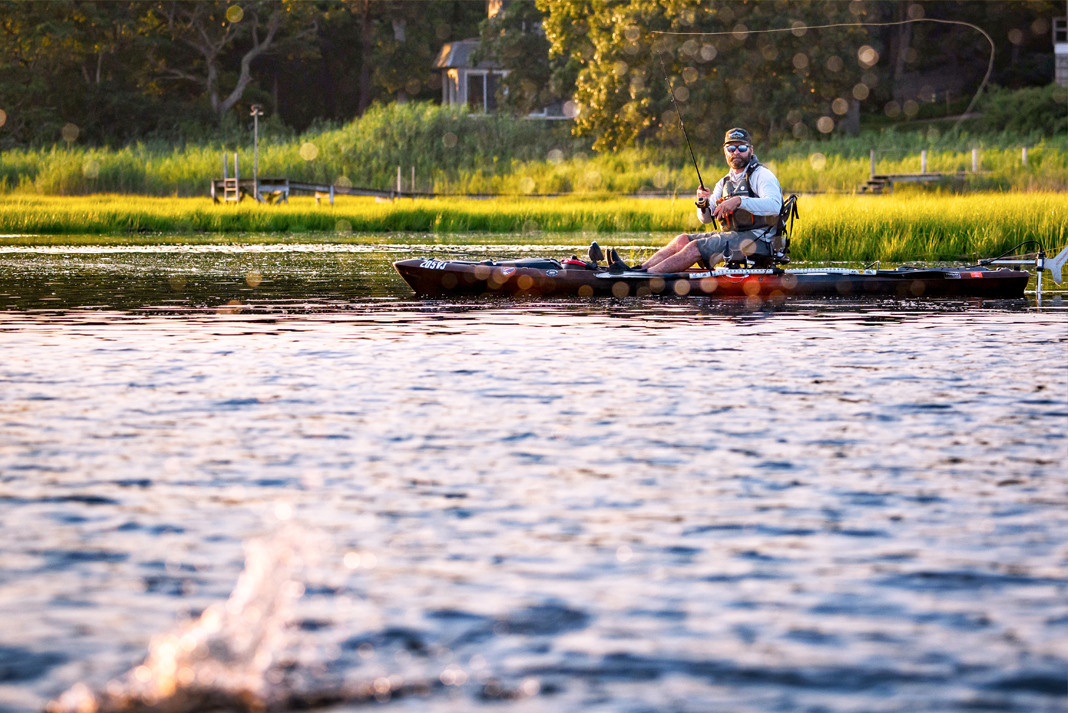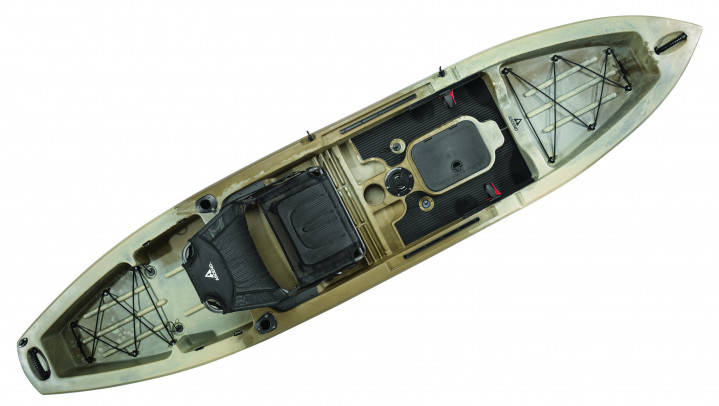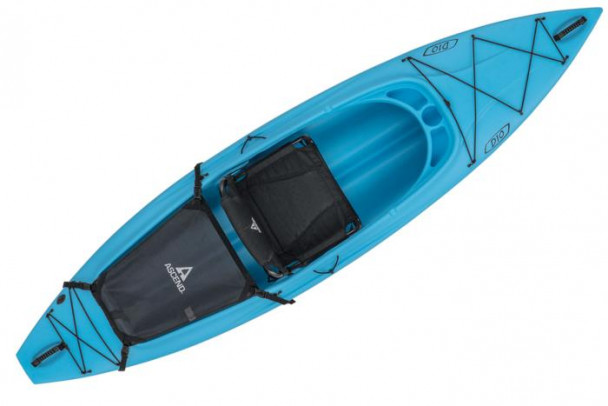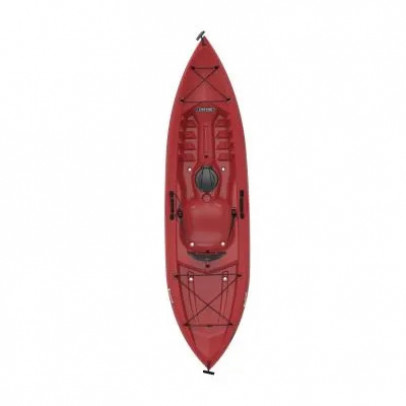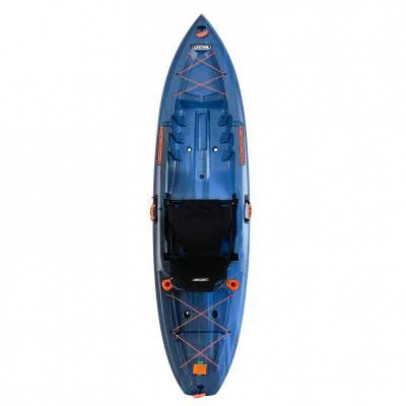The Ascend 10t is a sit-on-top fishing kayak with a host of useful features geared toward anglers. The elevated seat, standing platform cockpit and large tankwells leave no question this boat was built to chase fish.
Ascend kayaks are a brand under the banner of the White River Marine Group. By volume, the White River Marine Group is the world’s largest manufacturer of motorized boats. The White River Marine Group is owned by Bass Pro Shops. Not surprisingly, Ascend kayaks are most commonly available at Bass Pro Shops, Cabela’s, and also boating retailers who carry White River Marine Group brands.
What makes the Ascend 10t stand out within a sea of fishing kayaks? It incorporates an elevated seat and a platform-style cockpit, which we will discuss further below. These design features are commonly found on kayaks much more expensive than the 10t. That being said, the 10t does have a higher price tag than some other fishing kayaks available at large retailers.
So, is the Ascend 10t worth it? We’ll try to help you answer that in this Ascend 10t review.
On the water with the Ascend 10t
Ascend 10t Specs
Length: 10’0” / 3 m
Width: 30” / 76 cm
Weight: 67 lbs / 30 kg
Capacity: 325 lbs / 147 kg
MSRP: $679 USD / $999 CAD
Performance
What are anglers looking for in a kayak? Often it’s the ability to get where conventional motorized boats can’t, without sacrificing storage space or stability for casting. There’s also the appeal of skipping out on the hassle of owning a motor boat, and the chance to turn everyday fishing into a bit of an adventure. With this said, let’s talk performance and the Ascend 10t kayak’s stability.
The Ascend 10t sit-on-top kayak is built on a tunnel hull. Tunnel-hulled kayaks are generally wider than other kayak hulls. Think of a tunnel hull as a pontoon boat or catamaran. There are essentially two rounded hull surface areas bridged by the center of the kayak. The dual, rounded surface areas provide reliable initial and secondary stability. These tunnel hulls are especially popular with fishing kayakers for the stable platform they provide.
The tunnel hull enables the Ascend 10t’s standing platform area. What do I mean by standing platform in a kayak? It’s when the floor of the cockpit is an open, flat area, rather than being scooped out for a footwell. This gives a kayak angler the opportunity to sight fish and increase casting ability. It’s a next step up in the fishing capability of a kayak.
The Ascend 10t features this open standing area. But the 10t dimensions are worth looking at when assessing the stability of the kayak. The 10t is 10 feet long and 30 inches wide. In comparison to other fishing kayaks with a standing platform, the 10t is on the small side. For this reason, inexperienced paddlers may find the 10t feels unstable when it comes to standing.
Market and demographics
The Ascend 10t is a sit-on-top fishing kayak. Sit-on-top kayaks are kayaks where the paddler is not enclosed at all. They sit on the deck of the boat, which has been molded for an exterior seating position. This is in comparison to a sit-inside kayak. A sit-inside kayak is one where the paddler slides into the cockpit of the kayak. They may also wear a sprayskirt to cover the cavity of the cockpit. Sit-on-top kayaks have become popular for fishing kayaks because of their ease of entry, open storage and easier rescue scenarios in the event of a capsize.
The Ascend 10t kayak was designed specifically with the kayak angler in mind. The elevated seat position and tunnel hull make the 10t less about covering water as a paddler, and more about comfort and stability.
This kayak is best-suited for slow-moving rivers, lakes and sheltered coastal waterways.
Beyond rod and reel action, kayaks like the Ascend 10t can also be used for hunting. With the Ascend 10t, duck hunting is well within scope. The open cockpit design and large tankwells are conducive to carrying decoys, setting up a shotgun rack or even bringing along your bird dog.
About the Ascend 10t
Design
Material and construction
The Ascend 10t is constructed of high-density polyethylene. Polyethylene is a plastic commonly used in kayak manufacturing. This polymer compound is also regularly used to make other common plastic goods like milk jugs and shampoo bottles.
Ascend produces the 10t through a rotomolding process. Small plastic pellets are loaded into a mold. The mold is then placed in a large oven at high temperatures and rotated at a speed, pushing the liquified nurdles outward so they spread and take the shape of the mold. While the mold is pulled from the oven it continues to rotate as it cools. When the mold is opened, presto we have a kayak. Rotomolding is one of the standard production processes in the industry for producing durable kayaks.
Ascend 10t accessories and outfitting
One of the most obvious elements of the Ascent 10t is the amount of open storage.
This starts at the bow, where the Ascend 10t has a roomy forward tankwell. Tankwells are storage areas molded into sit-on-top kayaks. The tankwells of the 10t have plenty of space for storing tackle and drybags for a day on the water.
On the floor of the forward tankwell there are four metal D-rings. These rings provide tie-down points to secure your gear. Many fishing kayaks commonly include bungee cords pre-installed on a deck rigging system. On the Ascend 10t you have to run your own bungee, or other type of cord. I do not see this as a disadvantage, but rather a blank slate. The D-rings provide good anchor points to run the length of cord you choose.
Another thoughtful design element of the Ascend 10t’s front tankwell is the cut-out where it meets the cockpit, allowing water splashing over the bow to drain out into the floor of the cockpit, where it will exit via the scupper holes.
The cockpit of the 10t Ascend kayak is an open concept, with an overall flat surface, covered with traction padding. This deck mat and flat surface allows kayak anglers to use the floor of the cockpit as a standing platform. A standing platform increases your ability to cast, sight fish and move around the deck.
Also within the cockpit of the Ascend 10t are sliding foot braces. Sliding-style foot braces provide more positions than molded-in footwells. They do, however, require you to reach down toward your feet if they need adjustment on the water. Foot braces are an important part of a kayak’s outfitting because they provide a point of contact with your kayak. This gives you more leverage for paddling strokes, and more control over the kayak.
At the center of the cockpit between the foot braces there is a small dry hatch for storage. This hatch is sealed with a threaded deck plate. The hatch is a good place to store small items.
On the floor of the cockpit you will see four scupper plugs. Why exactly are there holes in the bottom of the kayak? These scupper holes are there to let water that enters the boat drain out through the floor. This keeps the cockpit of the kayak from filling with water. The Ascend 10t has six scuppers in total. Four are in the cockpit, and two in the rear tankwell.
Water can also come up through the scuppers. If you are paddling in calm conditions, and don’t want water to splash up through the floor, you may want to close the scupper holes. You can do this with a set of scupper plugs. Ascend has included scupper plugs with the 10t.
The seat of the Ascend 10t fishing kayak is an elevated, lawn-chair-style seat. It has a mesh construction, with some padding under the butt and on the back. The raised seat provides a more natural posture and sitting height. An elevated seat also increases visibility, and keeps you off the wet floor of the kayak.
The Ascend 10t kayak seat has a unique track system. Near the hinge on each side of the seat are small plastic blocks. These blocks slide into an enclosed track, rather than resting on top of a track. This keeps the seat from bouncing up off its position, but also means if you want to move it out of the way you must slide it forward, rather than just folding upward. This is not necessarily an advantage or disadvantage. It does make for a specialized system, though, creating difficulty for any Ascend 10t seat upgrade.
One area of concern cited by users of the Ascend 10t is the seat’s vulnerability to rusting. A rusted out elevated seat would render the kayak relatively useless until you have a replacement seat.
The area around the cockpit of the Ascend 10t also features pre-installed accessory tracks, on either gunwale near the knees. This provides a place to easily mount electronics on your 10t such as a fish finder or camera. It’s a simple pre-installed add-on, but saves time and money for a kayak angler who wants to have a boat ready to launch the day of purchase.
Behind these accessory tracks and closer to the seat, the Ascend 10t includes two carry handles. These handles are in great positions if you need to hop out of the kayak and perch it on a shoreline. The handles can also be helpful if you fall out of the 10t and need to climb back in. The included grab handles within the cockpit are in a great spot to aid in standing up or sitting back down in the seat.
Behind the Ascend 10t kayak seat are two flush-mounted rod holders. Flush-mounted rod holders are a common standard found on fishing kayaks, and give you the space to carry two rigged setups.
Near the stern of the Ascend 10t is another large, recessed tankwell. This tankwell is elongated and rectangular, and can accommodate a small cooler or milk crate. There are also two scupper holes for drainage under the tankwell.
At the stern you will find the drain plug. The drain plug allows you to empty any water which has entered the interior of the hollow hull of the Ascend 10t. How can water get inside a sit-on-top kayak? Water ingress can occur at seams, screw holes or places where the hull has been cut for exterior components. It’s not uncommon to get a small amount of water inside your kayak, and you should drain it at the end of your trip.
Ascend 10t kayak mods
Kayak anglers are known to seek out upgrades to their paddle craft. One common upgrade with this model is an Ascend 10t seat raise.
The seat of the Ascend 10t is already elevated. If it isn’t high enough, check out DIY videos of how other anglers have mounted rails on the deck of the 10t to further raise the seat height.
Before you go installing new rails on the Ascend 10t and making a lifeguard stand out of your kayak though, spend some time in the 10t as is and consider if a seat raise is actually needed. The higher the seat, the higher your center of gravity. Translation: you lose stability. When the water gets rough you may appreciate the opportunity to be sitting a little closer to the boat.
Another easy add-on is a forward, swiveling rod holder.
The Ascend 10t only has the two built-in rod holders behind the seat. You may want a rod holder directly in front of you for when you are actively fishing. Thanks to the pre-installed accessory mounts, this is as simple as picking up a rod holder to slide on. Ram and Scotty are popular brands to check out for these components.
When making modifications to the Ascend 10t, consider that a paddle holder is not included on the deck of the kayak. This is a simple, cheap, yet extremely helpful upgrade to secure your paddle while fishing. You can make some extreme modifications to your 10t, but little details like adding a paddle holder will make a huge difference in your experience.
The Ascend 10t is a stable, pontoon kayak which could accommodate a trolling motor. There is no trolling motor available directly from the manufacturer, however. Anglers looking to motorize their 10t will have to fashion a DIY-driven, after-market installation of a trolling motor for the 10t.
Warranty
Ascend provides a one-year, limited warranty covering parts and labor to correct defects in materials and workmanship.
How it compares
The Ascend 10t finds itself in a crowded class of fishing kayaks. Here are a few regularly compared with the 10t.
-
Ascend 10t vs 12t
The kayak in the Ascend line most comparable to the 10t is the Ascend 12t. The major difference between these two kayaks comes down to dimensions, and how those dimensions affect the layout of the kayak.
The 10t is so-named because it is 10 feet long. This is two feet shorter than the 12-foot 12t. The 30-inch-wide 10t is also one inch narrower compared to the 31-inch-wide 12t.
The 12t’s stern tankwell is larger than the 10t, and is shaped into multiple segments.
Another storage difference is that the 12t has an additional dry hatch compartment within the cockpit. It is accessible through a rectangular, hinge-operated deckplate.
The difference in size is also going to equate to a difference in weight. The 10t weighs less at 67 pounds compared to the 12t at 77 pounds. It also has a lighter capacity at 325 pounds compared to the 12t’s 350 pounds.
The two kayaks are close to par with one another. The increased dimensions of the 12t may give it an edge in storage, stability and perhaps a bit of speed. If carrying weight and size limitations are more of a factor, the 10t should appeal.
-
Ascend 10t vs Pelican Catch 100
A similar design to the Ascend 10t is the Pelican Catch 100.
Pelican’s Catch 100 is also a 10-foot sit-on-top kayak with a tunnel-shape hull. It also features an elevated seat, sliding foot braces and a flat-standing platform in the cockpit.
Some small differences standing out between the two boats are the storage and built-in accessories. The Ascend 10t kayak has two open tankwells, one in the bow and one in the stern. The Pelican Catch 100 has an open tankwell in the stern, but an enclosed hatch in the bow.
The Pelican Catch 100 also features four rod holders behind the seat, and a bungee to secure your paddle to each side of the seat.
The largest difference between the two, when it comes to performance, may be the width. The Pelican Catch 100 is a full four inches wider than Ascend 10t. Generally speaking, with similar hulls this is going to translate to lower speeds but more stability for the standing platform.
-
Ascend 10t vs H10
The Ascend H10 is what Ascend has dubbed a hybrid kayak. It is not quite a sit-inside or sit-on-top kayak, but somewhere in between. It has a recessed cockpit surrounded by a deck, similar to what you would find for a sit-inside, but the cockpit is open and squared off.
The H10 features storage hatches in both the bow and stern, covered with a hard plastic deckplate in the bow, and plastic fabric cover in the stern. Once again following the hybrid mentality, these storage areas fall somewhere in between an open tankwell and an enclosed hatch.The intention is to provide storage for long outings and even overnighters. There are, however, no bulkheads built in to isolate sections of the kayak. Any water entering the H10 will not drain through a scupper and should the boat capsize it will take on water. This makes the H10 only suitable to paddle on calm or sheltered waterways.
On the other hand, the Ascend 10t will drain water. And should you fall overboard, all you have to do is climb back on. There is no open cavity where water will collect. While it is open air, the 10t kayak has plenty of storage space in the open tankwells, where gear can be stowed within drybags. For this reason, the 10t feels like a much more versatile craft.
-
Ascend D10 vs 10t
Another kayak from Ascend you may find in stores alongside the 10t is the D10.
The D10 is a sit-inside kayak where the paddler slides into the cockpit, whereas the 10t is a sit-on-top kayak.
The D10 is a recreational kayak intended for sheltered waterways and slow-moving rivers. It does not feature the gadgetry of the 10t geared toward anglers. The D10 is a great option if fishing is secondary to the paddling trip, and you intend to take in the views more often than casting a line.
-
Ascend 10t vs Lifetime Tamarack
The Lifetime Tamarack Angler 100 is a kayak you’ll often see sharing the water with the Ascend 10t. The Tamarack is a more traditional, sit-on-top kayak. What I mean by traditional is the paddler is sitting on the floor of the cockpit, in a molded-in seat, not on an elevated seat. The Tamarack also has a flat bottom compared to the tunnel hull of the 10t. The Tamarack has footwells, and does not include the flat standing area featured on the Ascend 10t. The Tamarack is suited for seated fishing.
The Ascend 10t provides the comfortable elevated position, but also comes with added weight from the size of the tunnel hull to provide a larger platform. The Ascend 10t is 67 pounds compared to the Tamarack at 51 pounds. This can be a major factor when considering transporting your kayak
When deciding between the Ascend 10t and Lifetime Tamarack Angler 100 you will want to ask whether you prefer the elevated position of the 10t, or low position of the Tamarack Angler 100.
-
Ascend 10t vs Lifetime Teton
Lifetime also produces the Teton Angler 100 sit-on-top kayak. You may notice the Teton has features of both the Ascend 10t and the Lifetime Tamarack mentioned previously. The Teton has a flat bottom hull just as the Tamarack. The Teton, however, has an elevated seat similar to the Ascend 10t. This keeps the paddler off the floor of the boat.
While the Teton has an elevated seat, it does not have a flat standing area, and is intended for seated fishing. Without a tunnel hull, and at just 30.5 inches wide, the elevated seated position of the Teton may easily feel less stable than the Ascend 10t. This would be a major factor when deciding between the two kayaks.
-
Ascend 10t vs FS10t
The FS10t from Ascend takes the sit-inside kayak deck of the D10 mentioned previously and adds on the features of a fishing kayak. It has two rod holders behind the seat. The FS10t also has accessory tracks on each side of the cockpit, and a small storage tray at the front of the cockpit, which can be helpful when sorting out your lures or rigging up a line.
The FS10t differs from the 10t in that it is a sit-inside kayak, where the paddler slides inside the kayak, rather than sitting out in the open as the paddler does in the 10t. The FS10 also features a different style of hull: a V-shape, rather than the tunnel of the 10t. The 10t is designed for elevated sitting and even standing, and the FS10t is not at all. When deciding on the style of kayak fishing you would like to do, this will be an important consideration.
Ascent 10T Comparison
Where to buy the Ascend 10t
Where can you find the Ascend 10t available for purchase? Bass Pro and Cabela’s carry the 10t. You will also find Ascend kayaks available at a limited number of smaller local boating stores that carry White River Marine Group brands.
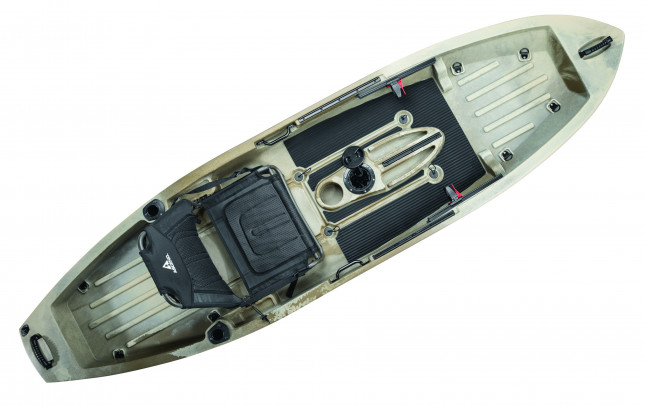
10T Sit-On-Top Kayak
- Rotomolded, custom-crafted tunnel hull
- Exceptional stability for standing and fishing
- Bow and aft powder-coated steel D-rings for securing gear
- Flat casting deck with non-skid foam mat
- Port, starboard, centerline accessory-mounting rails
Ascend 10t Pros and cons
Pros
- Sit-on-top design provides easy entry and open storage for fishing
- Elevated seat provides comfortable seating and better casting
- Standing platform for sight fishing and active fishing
- Large tankwells for storage
Cons
- Narrow width makes standing stability suspect
- Tunnel hull is heavier than other kayaks
- Seat is known to rust
Related articles
Ascend kayak reviews
Sit-on-top fishing kayak reviews
- Recreational Kayak Review: Wilderness Systems Tarpon 100
- Fishing Kayak Review: SeaStream Angler 120 PD
- Recreational Kayak Review: Ocean Kayak Frenzy
- Fishing Kayak Review: Sun Dolphin Journey 10
- Fishing Kayak Review: Ascend 12t
- Fishing Kayak Review: Sun Dolphin Boss 12 SS
- Fishing Kayak Review: Lifetime Tamarack Angler 100
- Fishing Kayak Review: Ascend 128t
- Fishing Kayak Review: Wilderness Systems Recon 120 HD
- Fishing Kayak Review: Perception Pescador 12
10-foot fishing kayak reviews
- Kayak Review: Sun Dolphin Excursion 10
- Fishing Kayak Review: Ascend FS10
- Fishing Kayak Review: Old Town Vapor 10
- Fishing Kayak Review: Pelican Mustang 100x
- Fishing Kayak Review: Old Town Sportsman 106 Minn Kota
- Recreational Kayak Review: Pelican Bandit NXT 100



